To put things in Mathematical jargon, Sarah and Mary are congruent to one another since they look exactly alike. Fiona and Michelle are similar to one another as they only share certain features.
The words "congruent" and "similar" are two important terms in Geometry used to compare shapes or figures. This article will discuss this concept and look into its applications.
Definition of Similar and Congruent Shapes
To start this discussion, let us begin by looking at the diagram below.

Square A and B and Rectangle C and D example
What do you notice about squares A and B and rectangles C and D?
To answer this question, Squares A and Square B are identical since both their sides are exactly the same measure. Furthermore, they share the same shape. However, Rectangle C and Rectangle D are not identical, although they are of the same shape. In this case, both their heights and widths are different in length. Hence, we can draw the following conclusion:
From here, we can define similar and congruent shapes as below.
Two shapes are congruent if they are exactly the same shape and size.
Two shapes are similar if they are exactly the same shape but different sizes.
The term shape here refers to the general form of two (or more) given shapes in the plane. As with our example above, shapes A and B are classified as squares while shapes C and D are classified as rectangles. On the other hand, the term size refers to the dimensions or measures of the figure.
The Similarity and Congruence Test
Now here comes an interesting question: How do you prove whether a pair of shapes is similar or congruent?
Well, the answer is through transformations! Recall that a transformation is a movement in the plane in which you can change the size or position of a shape. Examples include reflection, rotation, translation and dilation (enlargement). There are two ideas to the Similarity and Congruence Test for shapes:
If an image returns to its original shape upon rotation, translation or reflection, then it is congruent.
Similar shapes can be of different orientations. The image of a shape after dilation is similar to its original shape.
Be sure to familiarise yourself with these ideas so that you can efficiently identify similar and congruent shapes. Here is an example that demonstrates this.
Here we have two isosceles trapeziums called M and N.

Isosceles trapeziums M and N
Identify whether they are similar or congruent.
Solution
Given the information above, both M and N are exactly the same shapes. However, they seem to be of different orientations. Let's try to rotate trapezium N 180o to the right.

Isosceles trapeziums M and N after rotation
After this rotation, we find that M and N are of the same orientation. Now, we shall observe its given dimensions. The legs of both M and N are 8 cm. Furthermore, their upper and lower bases are identical, with measures of 3 cm and 5 cm respectively.
Since trapezium N yields exactly the same shape and size as trapezium M upon rotation, we can infer that both shapes are congruent to each other.
Let's say M and N were presented in the following orientations. Their original dimensions were kept the same as above. Are they still congruent?
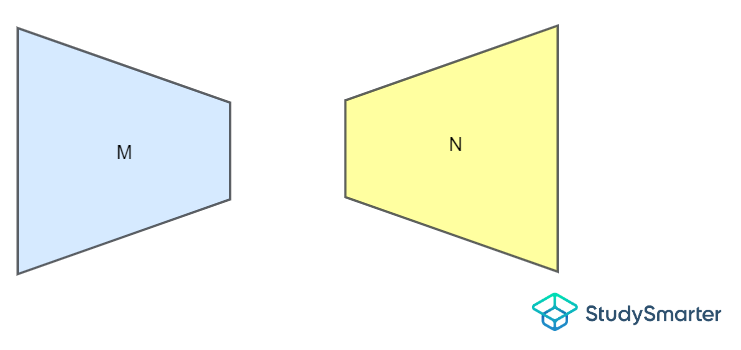
Isosceles trapeziums M and N after reflection
This is simply a case where a reflection is involved. Notice that M and N are reflections of each other. They produce the same shape upon reflection. Thus, M and N retain their congruency.
Now let us look at a similarity problem.
Here we have two more isosceles trapeziums P and Q.
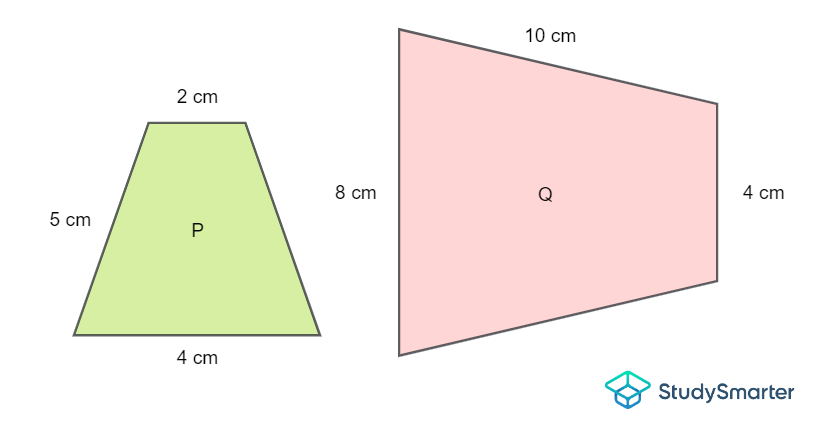
Isosceles trapeziums P and Q, Study Smarter Originals
Identify whether they are similar or congruent.
Solution
As mentioned in the description, we have two isosceles trapeziums P and Q. They are of the same shape but have different orientations. Furthermore, notice that the dimensions of trapezium Q are twice the measure of trapezium P. Thus, Q is two times the size of P since
Leg of P = 5 cm = 2 Leg of Q = 2 × 5 cm = 10 cm
Upper base of P = 2 cm = 2 × Upper base of Q = 2 × 2 cm = 4 cm
Lower base of P = 4 cm = 2 × Upper base of Q = 2 × 4 cm = 8 cm
In other words, trapezium Q is a dilation of magnitude 2 of trapezium P. Thus, they are similar.
Congruent Triangles
In this section, we shall observe the congruent properties of triangles.
A pair of triangles are said to be congruent if the length of its three sides and the measure of its three angles are exactly the same.
A triangle can change its position but maintain the length of its sides and the measure of its angles through rotation, reflection and translation.
Rotation | Reflection | Translation |
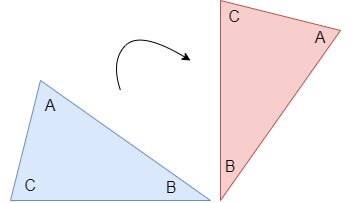
Rotation | 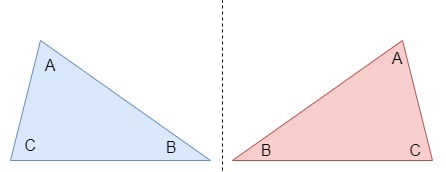
Reflection | 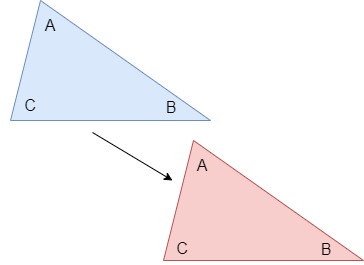
Translation |
When solving congruent triangles, be careful of the location of the equal sides or angles. When comparing two triangles, orientation plays a very important role!
There are five ways to identify whether a pair of given triangles are congruent. Note that the letters A, S, H and L represent the terms Angle, Side, Hypotenuse and Leg respectively.
The leg of a right triangle describes the length of the adjacent and opposite sides.
Congruence Theorem | Concept | Example |
SSS Congruency | If three sides of one triangle are equal to three sides of another triangle, then both triangles are congruent | 
SSS Congruency |
SAS Congruency | If two sides and an included angle of one triangle are equal to the corresponding two sides and included angle of another triangle, then both triangles are congruent | 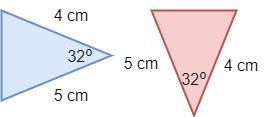
SAS Congruency |
ASA Congruency | If two angles and an included side of one triangle is equal to the corresponding two angles and included side of another triangle, then both triangles are congruent | 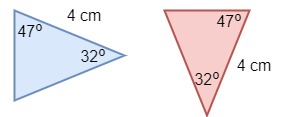
ASA Congruency |
AAS Congruency | If two angles and a non-included side of one triangle is equal to the corresponding two angles and the non-included side of another triangle, then both triangles are congruent | 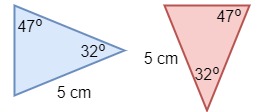
AAS Congruency |
HL Congruency (Applies to right triangles only) | If the hypotenuse and one leg of one right triangle are equal to the corresponding hypotenuse and leg of another right triangle, then both triangles are congruent | 
HL Congruency |
If three angles of one triangle are equal to three angles of another triangle, the two triangles may not necessarily be congruent as they may be of different sizes.
Similar Triangles
Remaining in the realm of triangles, we will now study their similarity properties.
A pair of triangles are said to be similar if all three of their angles are equal and the corresponding sides are of the same ratio.
Essentially, two triangles are similar if they only vary in size. This means that any of the transformations previously mentioned – reflection, rotation, translation and dilation – are allowed between two similar triangles.
Similarity Theorems
There are four ways to identify whether a pair of given triangles are similar.
Similarity Theorem | Concept |
AA Similarity | If two triangles have two equal angles, then the triangles are similar 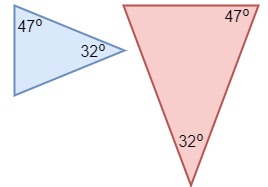
AA Similarity |
SAS Similarity | If two triangles have two pairs of sides of the same ratio and an equal included angle, then the triangles are similar 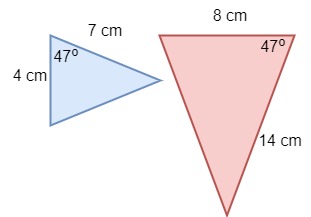
SAS Similarity |
SSS Similarity | If two triangles have three pairs of sides of the same ratio, then the triangles are similar 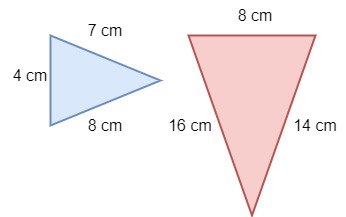
SSS Similarity |
The Side-Splitter Theorem | 
Side-splitter theorem For a triangle ADE, if BC is parallel to DE, then \(\frac{AC}{CE}=\frac{AB}{BD}\) |
The Angle Bisector Theorem | 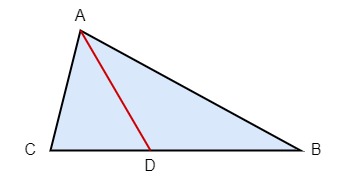
Angle bisector theorem For a triangle ABC, if AD bisects Angle BAC, then \(\frac{AC}{CE}=\frac{AB}{BD}\) |
An angle bisector splits an angle into two equal halves.
Areas of Similar Shapes
Coming back to the definition regarding two similar shapes, you must have in mind this important word: ratios. The ratios between the lengths of two corresponding sides of two given shapes will build a relation between their areas. This brings us to the following statement for the area of similar shapes.
Given a dilation (or enlargement) of scale factor \(n\), the area of the larger shape is \(n^2\) times the area of the smaller shape.
In general, if two similar shapes have sides in the ratio \(x:y\), then the ratio of their areas is \(x^2:y^2\).
Notice that the scale factor has an exponent equal to 2. Let us demonstrate this with the following diagram. Here we have two shapes, M and N.
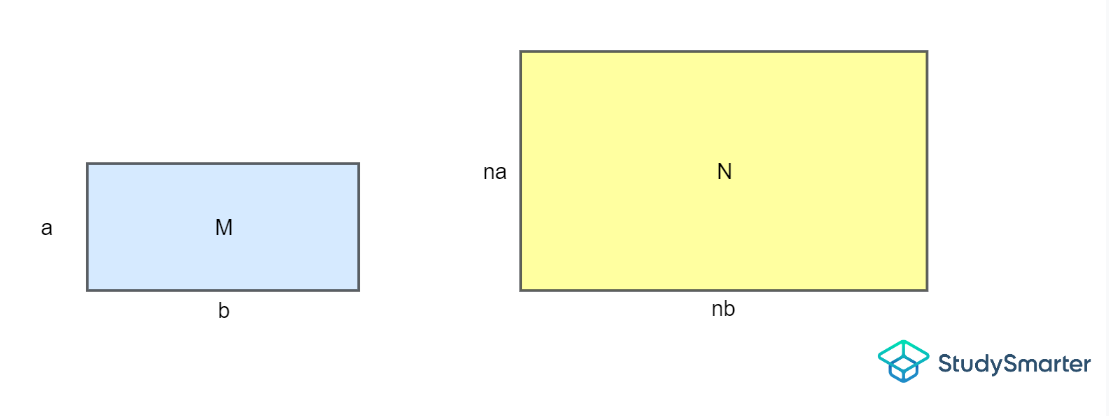
The area of similar shapes M and N
The area of shape M is
\[\text{Area of M}=a \times b\]
and the area of shape N is
\[\text{Area of N}=na \times nb=n^2 ab\]
where \(n\) is the scale factor in this case. Here is an example that demonstrates this idea.
Rectangles A and B are similar. The area of Rectangle A is 10 cm2 and the area of rectangle B is 360 cm2. What is the scale factor of enlargement?
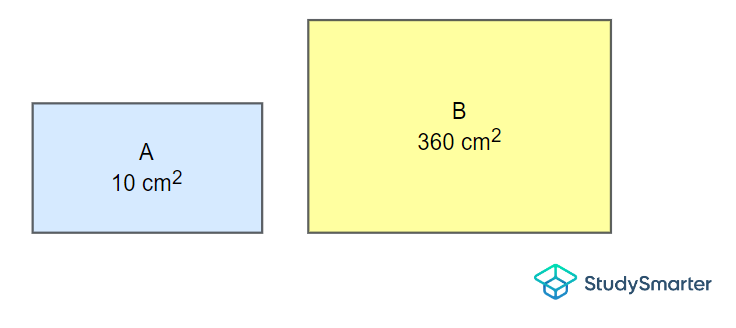
Example 1, StudySmarter Originals
Solution
We can use the formula \(\text{Area A}n^2=\text{Area B}\) to determine the scale factor \(n\) (refer to Shapes M and N shown previously). Given the areas of A and B, we obtain
\[10n^2=360\]
Dividing 10 on both sides,
\[n^2=36\]
Now taking the square root of 36 yields,
\[n=6\]
Note that the scale factor is always taken as positive!
Thus, the scale factor is 6.
Let's look at another example.
Squares X and Y are similar. The sides of Squares X and Y have side lengths given by the ratio \(3:5\). Square X has a side length of 6 cm.
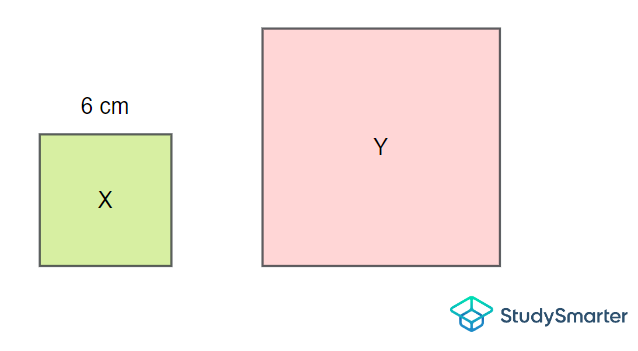
Example 2, StudySmarter Originals
- Find the side length of Y.
- Calculate the area of Y.
- Dedude the ratio of area X to area Y.
Solution
Question 1: Here, we can simply use the given ratio.
\[\text{Side length X}:\text{Side length Y}=3:5\]
Expressing this ratio into fractions, we obtain
\[\frac{3}{5}=\frac{6}{\text{Side length Y}}\]
Solving this yields
\[\text{Side length Y}=\frac{6\times 5}{3}=10\]
Thus, the length of side Y is 10 cm.
Question 2: Next, we will use the formula for the area of the square. Since we have found the side length of Y in Question 1, which is 10 cm, we can evaluate the area as
\[\text{Area Y}=10\times 10=100\]
Thus, the area of Y is 100 cm2.
Question 3: Here, we first need to deduce the area of Square X. Given that its side length is 6 cm, then
\[\text{Area X}=6\times 6=36\]
Hence, the area of X is 36 cm2. As we have now found both the area of X and Y, we can write the ratio of \(\text{Area X}:\text{Area Y}\) as
\[36:100\]
To simplify this, we need to divide the ratio by 4 on both sides. This yields,
\[9:25\]
Thus, the ratio of Area X to Area Y is \(9:25\).
Volumes of Similar Shapes
The volume of similar shapes follows the same idea as the area of similar shapes. As before, the ratios between the lengths of two corresponding sides of two given shapes will build a relation between their volumes. From here, we can deduce a general idea for the volume of similar shapes.
Given a dilation (or enlargement) of scale factor \(n\), the volume of the larger shape is \(n^3\) times the volume of the smaller shape.
Essentially, if two similar shapes have sides in the ratio \(x:y\), then the ratio of their volumes is \(x^3:y^3\).
Observe that the scale factor is of power 3. We shall now exhibit this concept in the figure below. Here we have two shapes, P and Q.

The volume of similar shapes P and Q, StudySmarter Originals
The volume of shape P is
\[\text{Volume of P}=a \times b\times c\]
and the volume of shape Q is
\[\text{Volume of Q}=na \times nb\times nc=n^3 abc\]
where \(n\) is the scale factor in this case. To obtain a clearer view, let us look at some worked examples.
Here we have two similar triangular prisms M and N. The volume of M is 90 cm3. What is the volume of N? What is the ratio of Volume M to Volume N?

Example 3
Solution
To tackle this problem, we first need to find the scale factor of enlargement. Notice that a pair of corresponding side lengths of M and N are given in the figure above. We can use this information to find the unknown scale factor.
\[\frac{21}{7}=3\]
Thus, \(n=3\) is the scale factor. From here, we can use the formula \(\text{Volume M}n^3=\text{Volume N}\) (refer to Shapes P and Q shown previously) to find the volume of N. Thus,
\[90\times 3^3=\text{Volume N}\]
Solving this yields
\[\text{Volume N}=2430\]
Therefore, the volume of N is 2430 cm3.
Since we have now deduced both the volumes of M and N, we can write the ratio of \(\text{Volume M}:\text{Volume N}\) as
I am running a few minutes late; my previous meeting is running over.
\[90:2430\]
Simplifying this by diving both sides by 90, we obtain
\[1:27\]
Thus, the ratio of Volume M to Volume N is \(1:27\).
Here is another worked example.
Here we have two rectangular prisms P and Q. The volumes of P and Q are given by 30 cm3 and 3750 cm3 respectively. Determine the dimensions of Q.
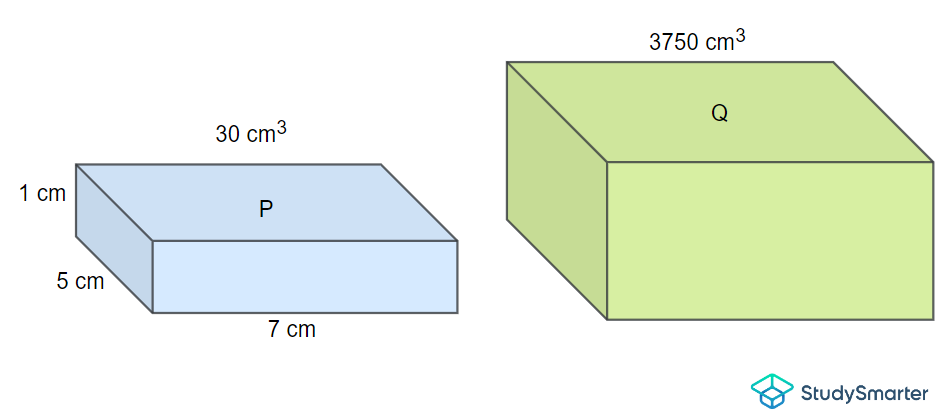
Example 4
Solution
The first thing we need to do here is to find the scale factor of enlargement, \(n\). Since we are given the volume of P and Q, we can use the formula \(\text{Volume P}n^3=\text{Volume Q}\). In doing so, we obtain
\[30n^3=3750\]
Dividing both sides by 30, we obtain
\[n^3=125\]
Now taking the cube root of 125 yields
\[n=5\]
Thus, the scale factor is equal to 5. Given that the height, width and length of P are 1 cm, 5 cm and 7 cm respectively, we simply need to multiply each of these components by the scale factor we found to deduce the dimensions of Q.
Height of Q \(=1\times 5=5\)
Width of Q \(=5\times 5=25\)
Length of Q \(=7\times 5=35\)
Therefore, the height, width and length of Q are 5 cm, 25 cm and 35 cm respectively.
The area and volume of congruent shapes are always the same!
Examples of Similar and Congruent Shapes
In this final section, we shall observe a few more worked examples that encapsulate all that we have learnt throughout this discussion.
Similar shapes A, B and C have surface areas in the ratio \(16:36:81\). What is the ratio of their height?

Example 5
Solution
Let us denote the surface area of A, B and C by \(a^2\), \(b^2\) and \(c^2\) respectively. The ratio of these areas is given by \(16:36:81\). This in turn can also be expressed as \(a^2:b^2:c^2\).
Recall that if two similar shapes have sides in the ratio \(x:y\), then the ratio of their areas is \(x^2:y^2\). In this case, we have three sides!
The ratio of their height is \(a:b:c\). Thus, we simply need to find the square root of each component in the surface area ratio of A, B and C to determine the ratio of their height. Given the surface area ratio \(16:36:81\), the square root of 16, 36 and 81 is 4, 6 and 9. Hence, the ratio of the heights of A, B and C is
\[4:6:9\]
Here is another example.
Shapes X and Y are similar. Calculate the surface area of B.

Example 6
Solution
To begin, let us first calculate the surface area of X.
\[\text{Surface Area X}=2\times[(8\times 4)+(4\times 20)+(8\times 20)]=2\times 272=544\]
Thus, the surface area of X is 544 cm2. We will now compare the corresponding lengths in order to find the scale factor of enlargement. Here we are given the lengths of X and Y.
\[\frac{40}{20}=2\]
Thus, the scale factor is \(n=2\). We can now use this information to find the surface area of Y by using the formula \(\text{Surface Area X}n^2=\text{Surface Area Y}\)
\[544\times 2^2=\text{Surface Area Y}\]
Solving this yields
\[\text{Surface Area Y}=544\times 4=2176\]
Therefore, the surface area of Y is 2174 cm2.
Let us look at this next example.
Below are 3 pairs of congruent triangles. Determine what type of congruency they have and explain your answer.
| A | B | C |
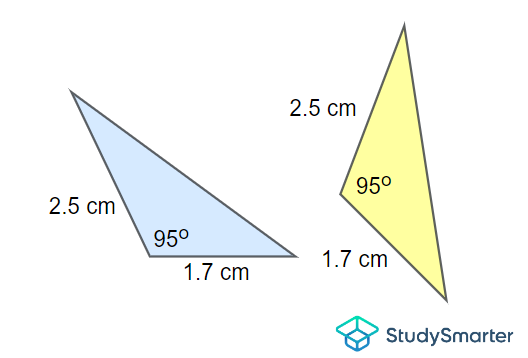
Example 7(a) | 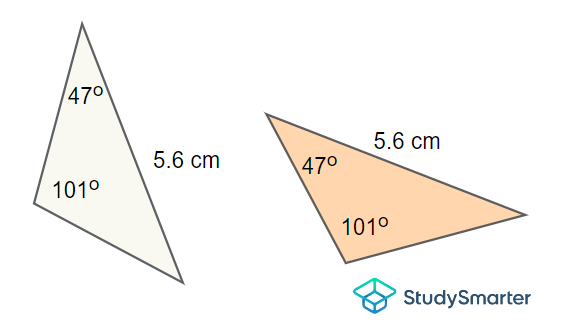
Example 7(b) | 
Example 7(c) |
Solution
Pair A is SAS Congruency since two sides and an included angle of the blue triangle is equal to the corresponding two sides and included angle of the yellow triangle.
Pair B is AAS Congruency since two angles and a non-included side of the white triangle is equal to the corresponding two angles and the non-included side of the orange triangle.
Pair C is ASA Congruency since two angles and an included side of the green triangle is equal to the corresponding two angles and included side of the pink triangle.
Almost done! Here is one more example for you.
Two similar solids have side lengths in the ratio \(4:11\).
- What is the ratio of their volumes?
- The smaller solid has a volume of 200 cm3. What is the volume of the larger solid?
Solution
Let us denote the smaller solid by X and the larger solid by Y and the side length of X and Y by \(x\) and \(y\) respectively. The ratio of their side lengths is written as \(x:y\) and is given by \(4:11\).
Question 1: Recall that if two similar shapes have sides in the ratio \(x:y\), then the ratio of their areas is \(x^2:y^2\). Thus, we would simply need to square the components in the ratio of side lengths X and Y to calculate the ratio of their volumes. The square of 4 and 11 is 16 and 121 respectively. Thus, the ratio of Volume X to Volume Y is
\[16:121\]
Question 2: Expressing this ratio into fractions, we have
\[\frac{\text{Volume X}}{\text{Volume Y}}=\frac{16}{121}\]
Now noting the given volume of X,
\[\frac{200}{\text{Volume Y}}=\frac{16}{121}\]
Rearranging this expression, we obtain
\[\text{Volume Y}=\frac{200\times 121}{16}\]
Solving this yields
\[\text{Volume Y}=\frac{3025}{2}=1512.5\]
Thus, the volume of Y is 1512.5 cm3.
Similar and Congruent Shapes - Key takeaways
- Two shapes are congruent if they are exactly the same shape and size.
- Two shapes are similar if they are exactly the same shape but different sizes.
- If an image returns to its original shape upon rotation, translation or reflection, then it is congruent.
- Similar shapes can be of different orientations.
- The image of a shape after dilation is similar to its original shape.
- Two triangles are said to be congruent if the length of their three sides and the measure of their three angles are exactly the same.
- Two triangles are said to be similar if all three of their angles are equal and the corresponding sides are of the same ratio.
- If two similar shapes have sides in the ratio \(x:y\), then the ratio of their areas is \(x^2:y^2\).
- If two similar shapes have sides in the ratio \(x:y\), then the ratio of their volumes is \(x^3:y^3\).




































